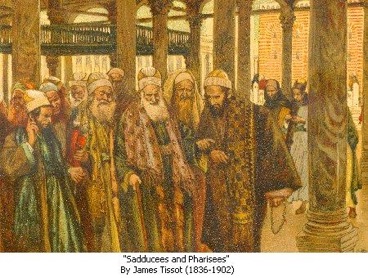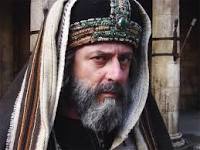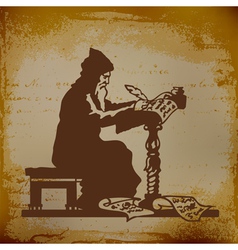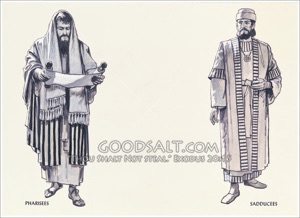Zadok is given by David the title of the high priest, 2 Samuel 8:17 & I Kings 2:27 (c. 1000 BC). Under Zadok, an influential priestly class arose. They become the Zadokite priesthood. Known in David’s time as the Sons of Zadok, their firm establishment is given in Ezekiel (593-571 BC, his time of writing): (44.10) “And the Levites who went far from Me, when Israel went astray… after their idols, they shall bear their iniquity.” (15) “But the priests, the Levites, the sons of Zadok, who kept the charge of My sanctuary (Jerusalem) when the children of Israel went astray from Me, they shall come near Me to minister to Me; and they shall stand before Me to offer to Me the fat and the blood,” says the Lord God.” In verse 24, their authority within the Assembly, later the Sanhedrin, is also established: “In controversy, they shall stand as judges, and judge it according to my judgments. They shall keep My laws and My statutes in all My appointed meetings, and they shall Hallow My Sabbaths.”
Ezra is highly regarded for
reestablishing Jewish purity
relative to the law, rebuilding
the 2nd Temple & reestablishing
social order.

Ezra assembling the Torah
EZRA REESTABLISHES JUDAISM
Artaxerxes commissions Ezra to re-establish the temple and Jewish law (458 BC). Over 4o,000 people accompany Ezra from Babylon, traveling to Mari and across the Fertile Crescent, then skirting Phoenician lands downward into Damascus and finally to Jerusalem. Ezra is noted as, “according to the law of thy God which is in thine hand” (Ezra 7:14) and is descended from Zadok (Ezra 7:1–6). “Ezra the priest and teacher” (7:11), wrote his history with some later editing by others.
Under Ezra (450 BC) the reintroduction of strict adherence to Torah law is initiated, and most would say even needed, for the Jewish people of Jerusalem had fallen away and entered into intermarriage with pagans. Ezra wrote a complete Torah, used as a master copy, providing Judaism consistency within the law. The scribes and lawyers later referred to as the Scribal Authority, begin to ascend under Ezra’s influence and leadership. By reinitiating a Torah practice that emphasizes a stronger position for law, it is thought by many scholars that Ezra the Scribe, priest of Aaron and most knowledgeable of the law, limited the mystical vision of the Hebrew Bible. Centuries later, and under the authority and ministry of Jesus, this mystic heritage would reemerge.
During the time of Ezra, the Great Assembly (later the Sanhedrin) and synagogue were established. The Assembly served as the ruling body within the religion, made up of the most learned men of Ezra’s company. The synagogue provided for intellectual development within Judaism and regularly assembled the people. With this legal emphasis, a growing class of scribes developed, with the scribes maintaining many civil positions as a part of their duties. In the remaking of the Jerusalem society, the scribes slowly became ever more powerful. Throughout the new testimony, Jesus will often confront them.
Under Ezra, priests, religious and civil scribes, and lawyers of Mosaic law united the religion and the Jewish state. The Temple is also rebuilt. Centuries later, this intellectual influence led to a ‘reasoned’ law reform movement, or the purity laws, fostered by those known in Jesus’ day as the Qumran (Ossaean) Essene or the scribes and lawyers mentioned in the New Testament.
As for Ezra himself, even though his work is highly regarded, he represents the transition from the time of the prophets into the time of law. This transition into a much more legal view of Judaism contributes to a lack of prophetic leadership during the period dating from 435 BC until the advent of Jesus (see Mt. 23.29-32). It becomes clear that the lawyered structure of thinking begins to take precedence over revelation and prophetic speaking.
COMETH the GREEKS
With the invasion of Alexander the Great, Judaism begins to change unalterably. Once the Greek Seleucid empire was established (312 BC) many of the Zadokite priesthood (Greek=Sadouks) slowly fell into an unhealthy Grecian influence, politically, religiously, and socially. Politics overshadowed religious purity. They became enamored of themselves as wealth flowed into the Sadducee priesthood. Later, the Tobiad family was assigned tax-collecting duties by the Greeks, and the Tobiads aligned themselves with the Greeks and the Sadducees, bringing in even more wealth. The Sadducee priests were wealthy enough to maintain ‘summer homes’ in the Greek region of Pella, for instance, even after the Greeks were defeated in Judea. These become the corrupted Sadducees referred to in Jesus’ era.
The Greeks, of course, supported this priestly transition completely. The Sadducees were quite content with Greek culture and political power. Through the religious center of Jerusalem, Antiochus Epiphanes (175–164 BC), ruler of the Greek Seleucid Empire, hastens Hellenization to eliminate Judaism, to the point of destroying all copies of the Torah, as well as other measures. Hellenization is considered religiously usurping, and on a societal level becomes a cause for great conflict. This outrageous effort by Epiphanes eventually led to the Maccabean revolt in 167 BC.
During this chaotic transition, Sadducaic authority remained uncontested until the rise of the Pharisees (c. 200 BC) before the Maccabean war. The Pharisees were formed out of everyday people, the middle-class and Levitical priests who did not favor Sadducaic authority and contested the Sadducaic high priesthood. The Sadducees would now have to be considered a much more political/governmental sect and not a group that had the support of the people. However, with support from the Greeks, the Sadducees maintained Temple control and remained as the Temple priests. After the Maccabean war, the religious contention between Sadducees and Pharisees would continue.
Sadducees applied a literalist and more limited interpretation of Mosaic law. For example, they dismissed the need for Messiah, that is, following the Pentateuch they considered enough. In contrast, Pharisees developed the beginning of rabbinical schools that would have to be considered a more practical and flexible religious study. Between these two priesthoods, the splintering of Judaism begins.
The Zadokite priesthood now has three predominant groups: the worldly Sadducees who remain as the Temple priests and control the Jerusalem Temple; the Ossaean Essene who leave Jerusalem in protest to the Temple priests and how the Temple is administered, and who build their retreat in Qumran; and those later to be known as Nazarene Essene, who abided in Galilee and northward into Damascus. Pharisees would be considered as the former Levitical priesthood.
Of these, the Qumran Essene would direct themselves into an increasing attribution into legalism. In an attempt to become pure they would develop purity rituals: much more frequent bathing or entering into the mikvah, washing of hands inordinately, wiping the edge of the cup before and after drinking, and other similar rituals which attribute their purity before God. Holiness would be determined by outward actions as opposed to inner motives or intent. Pharisees also adopted this ritualistic adherence to the law, of which the deeper meaning of scripture was often left to make way for itself. The deeper understanding would be more closely represented by the Nazarenes, considered to be more mystic, dealing with the inner man or the character of the man. The false narrative of the Sadducees and Pharisees would be corrected by both John the Baptist and Jesus.
Ossaeans were a group of men who practiced celibacy. Thus, all new adherents had to come from outside the sect. They perceived themselves as ‘Keepers of the Way’, but their efforts degraded toward legalistic rather than a more omnibus spirituality. Being the main body of the scribes and lawyers, Jesus often contends with them. Scribes, lawyers, and Pharisees are almost always found together within the New Testament. The Sadducees themselves would remain outside this conflict, limiting themselves to the law only, the Pentateuch.
Briefly, the Pharisees were the fourth notable sect and comprised middle-class families. Some believe they may have been associated with the Herodian sect, who supported Herod, for the Pharisees sought Herod’s help in moving against Jesus. They begin as a priestly class (220 BC). It is later the Pharisees accept laymen. In Jesus’ day, one could pay for acceptance into this priesthood, and Jesus considered them corrupted (Mt. 23.14). They also took up Ossaean purity rituals. During the Hasmonean Dynasty (147 BCE-37 BCE approx.), skirmishes were fought between Pharisees and Sadducees, and hangings and assassinations (sicari) were carried out.
The mystical revelation of God, and the continuation of traditional prophetic speaking, are slowly pushed from the Jerusalem religious stronghold. Those preserving the higher mystic relationship with God eventually retreat toward the farther reaches of the kingdom, north and east from the Sea of Galilee and into the land of Hauran, bordering as far north as Damascus. These people are the Nazarenes, who also maintained a strong presence in Galilee.
The date of this retreat is approximately 150 BC. It seems clear that this retreat, led by the Teacher of Righteousness (unknown personage), started not long after Greek influence became pronounced. The first groups probably migrated not long after the beginning signs of breakdown within the Zadokite priesthood. “Consequently, in the eyes of the Jerusalem authorities, the Hauran was a refuge for malcontents and a veritable cesspool of apostasy, the home not only of the Nazarenes but also many other equally heretical groups. It was the place where the exiled prophets and their families had long ago retreated,” from Mysteries of the Bridechamber, chapter four, V. LePage, Inner Traditions.
Essenes were known as “the men of perfect holiness” to “separate from the habitation of unjust men” and to “atone for the land,” as was later written under the Community Rule for the operation of the Qumran retreat facility. It is not that the Nazarenes would disagree with these pronouncements, however, we shall later see Jesus the Messiah give the higher interpretation of the law, a law not just limited to the legalism of the Qumran Essene.

Within the Temple complex
The Sadducees would reject the development and interpretations of the
Pharisaic rabbinic schools. Further, Qumran Essene (scribes & lawyers)
would maintain a much more legalist stance, separating them from Nazarenes.
As we near the times of Jesus, the Temple priests, the Sadducees, would no longer qualify as conservators. Being the ascendant power, they had taken upon themselves more influence from the Greeks and Persians. Even though they were strict within the law, they no longer accepted Jewish oral tradition, as the Pharisees did, which left Sadducaic interpretation of the law brittle. From the internecine war and civil/religious contentions involved with the Sadducees, the Pharisees later emerged (78 BC) as a new power base within Judaism. The Sadducees remained the Temple priests of educated and wealthy families, but with the rise of the Pharisees, their overt power among the people was severely curbed. As Temple priests, the Sadducees maintained control within the Sanhedrin (Caiaphas), a critical factor when considering the trial of Jesus.
Pharisee & Sadducee
Accurate depiction of a Sadducee priest:
Hair well-trimmed, linen turban,
linen garments (Ez. 44.17-18).
Jesus and the Sadducees
As perceived by the Nazarene Essenes, and Jesus himself, the Sadducees had created major problems. The first deals with their adherence to what today is called Greek Rationalism. Greek Rationalism (Stoicism, Epicureanism) had invaded Sadducaic thinking, and the syncretism between Greek philosophers and Judaic religion had begun. Rationalism works well for disciplines such as mathematics, mathematical proofs, and the scientific method, also lending a practical approach to personal and social development. However, in such an atmosphere spiritual revelation or revealed knowledge might not fare so well. Witnessing or quickening of the spirit and the need for prophetical renewal does not lend itself to intellectual figuring. This structured approach describes the Sadducaic intent within Mosaic law.
 Concerning the Torah, the acceptance of Greek Rationalism meant the Sadducees maintained a more intellectual and literal interpretation of the law instead of maintaining any semblance of oral tradition. Jesus’ ministry was replete with oral tradition, including parables and references to prophets not always represented when discussing the law. Another problem, Sadducees would support the ruling Hasmonean (Jewish) kings after the Syrian Greeks were defeated in the Maccabean war. Still, later they maintained a comfortable relationship with the Romans. To give a most irritating example, Sadducee priests performed Temple sacrifices for the Romans twice daily, infuriating the Pharisaic order, just as it would Jesus. This contrivance of cooperation between Sadducees and Romans would later be used as leverage to crucify Jesus. In short, the Sadducees became the worldly rich and pandered to foreign powers.
Concerning the Torah, the acceptance of Greek Rationalism meant the Sadducees maintained a more intellectual and literal interpretation of the law instead of maintaining any semblance of oral tradition. Jesus’ ministry was replete with oral tradition, including parables and references to prophets not always represented when discussing the law. Another problem, Sadducees would support the ruling Hasmonean (Jewish) kings after the Syrian Greeks were defeated in the Maccabean war. Still, later they maintained a comfortable relationship with the Romans. To give a most irritating example, Sadducee priests performed Temple sacrifices for the Romans twice daily, infuriating the Pharisaic order, just as it would Jesus. This contrivance of cooperation between Sadducees and Romans would later be used as leverage to crucify Jesus. In short, the Sadducees became the worldly rich and pandered to foreign powers.
Running the Temple allowed for overseeing the temple tax. This tax is accrued under Mosaic law and is meant to maintain the Temple. The Sadducees’ misuse of tax funds allows them to maintain personal wealth and power. The disparity between the Nazarenes, and Jesus in particular, stemmed from a continuation of this monied influence. It is interesting to note that later the Pharisees made the temple tax mandatory by law and could seize property if it was not paid. This rapacious nature insinuates the Pharisees into a monied position within Jewish society: “Woe to you blind guides! You say, ‘If anyone swears by the temple it means nothing; but if anyone swears by the gold of the temple, he is bound by his oath’ ” (Matt. 23:15-18). Jesus castigates the lawyers (Qumran Essene) and Pharisees, but his statement is premised (v. 14) on improperly accumulated wealth.
*
By the time of Jesus’ birth, Judaism had become splintered. The populous was beginning to believe resolution could only come through Messiah—he who would give the final interpretation of the Law and the Prophets. The extreme popularity of John the Baptist illustrates this hunger. Yet, the Sadducees saw no need for the Messiah. This lack of belief in the need for a messiah became one more conflict with Nazarenes, the Pharisees, and many commoners. The Sadducees might not grasp the uproar concerning either John or Jesus except as a threat to their power. They would consider neither spiritually credible.
Even though in 78-76 BC the Pharisees replaced the Sadducees as the predominate sect, the Sadducees continued as the Temple priests. Their power and influence remained primarily in Jerusalem. Along with the Pharisees, they ruled within the religious court, the Great Sanhedrin, made up of chief priests, scribes, and elders. They were also assisted by the chief scribe of the Qumran Essene, perhaps a more weighty figure than Caiaphus himself, for it would be this chief scribe who would give the final interpretation in all matters. In the trial of Jesus, this chief scribe would have to be a central figure.

God Bless!

What’s Happening i am new to this, I stumbled upon this I’ve found It positively helpful and it has helped me out loads. I hope to contribute & help other users like its aided me. Good job.
I am really loving the theme/design of your blog. Do you ever run into any internet browser compatibility problems? A number of my blog audience have complained about my blog not working correctly in Explorer but looks great in Safari. Do you have any ideas to help fix this problem?
Use Safari…still the best platform.
I see You’re in point of fact a just right webmaster. The site loading
speed is incredible. It seems that you are doing
any distinctive trick. Moreover, the contents are masterwork.
you’ve performed a excellent process on this subject!